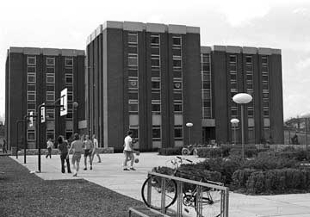
“Build It and They Will Come…” might well be the motto for Shorts Hall.
When Shorts – the first residence hall on campus for men - opened in 1968, two years after Madison College became coeducational, male enrollment, which had stagnated at about 10 percent for two decades, jumped to 18 percent. The following year it rose to 21 percent and by 1970, when Ron Carrier arrived, one quarter of the students were men. By the mid-1980s, men would make up almost half of the student population.
Men had always been a part of the school, even when it was the Normal, Harrisonburg Teacher's College and Madison College. Their presence was felt gradually throughout the century.
Coeducation, however, changed everything. Not only did it mean that men could attend Madison College as full-time regular students, but no longer were they limited to pursue only education degrees. They could study in any field from art to zoology.
The result was expansion of academic opportunities for both men and women.
But coeducation meant far more than just men on campus and new opportunities. It generated a new attitude. Madison College was a new college and students knew it. Faculty knew it. The new president knew it.
When Carrier came to Madison in 1970, he recognized the need to prepare students for the workplace. The era of pursuing college for purely intellectual or social reasons – a preoccupation that had lingered throughout higher education for centuries – was gone. Even though the attitude was never prevalent at Madison - a college serious about training teachers - its singular mission had been equally limiting. College, once the bastion of the elite, had become available to all students.
Ironically, the college's first president, Julian Burruss, had envisioned the need for such a change.
“To meet these demands of the new education it is obvious that the work of the Normal School can no longer be confined to theory and books, but must see its material in real things, in nature, in the practical activities of industry and commerce, in the business, civic and social interest of life,” Burruss wrote.
Carrier agreed. The philosophy gave the newly deemed coeducational college and soon-to-be deemed university carte blanche to prepare students for a diversity of careers, as well as for life.
New emphasis on pre-professional programs and internships provided new opportunities for students and also set them up to enter the workplace or graduate school with work-ready skills and experience. Pre-law, pre-physical therapy, pre-theology all drew from the solid base of scholarship already on campus and added to it a real world component quickly becoming a requisite for the job market.
Carrier also expanded graduate programs, which grew dramatically during the 1970s and 1980s, adding master's programs in exceptional education, fine arts and public administration, all leading to new career tracks. The first doctoral program, in psychology, would come at the end of his tenure.
Over the first Carrier decade, the school - where two-thirds of the students were pursuing degrees in education in the early 1970s - had developed a broad-based curriculum with two-thirds of the students studying subjects other than education.
Changes throughout campus were deep and broad. All, however, were grounded in a fundamental pursuit of quality that had long been valued by the faculty. Changes were driven, according to Thomas C. Stanton, vice president of academic affairs in 1976, by “the quality of academic programs,” combined with the “educational dynamics of a diverse faculty.”
Carrier also believed in students. With his firm confidence in their potential, new programs in the performing arts showcased student talents. The long-running JMU Dinner Theatre became a popular summer endeavor for the community. Believing that students could think for themselves, Carrier also turned over the half-million dollar student activities budget to students and let them run with it.
Carrier foresaw the coming technology revolution, one that would revolutionize communication, administration and student life. By the early 1980s, students were required to take courses in computer literacy. Later it would be new curricula underneath the umbrella of a new college, the College of Integrated Science and Technology, that would reflect both technological and curricular evolutions.
-- Martha B. Graham
